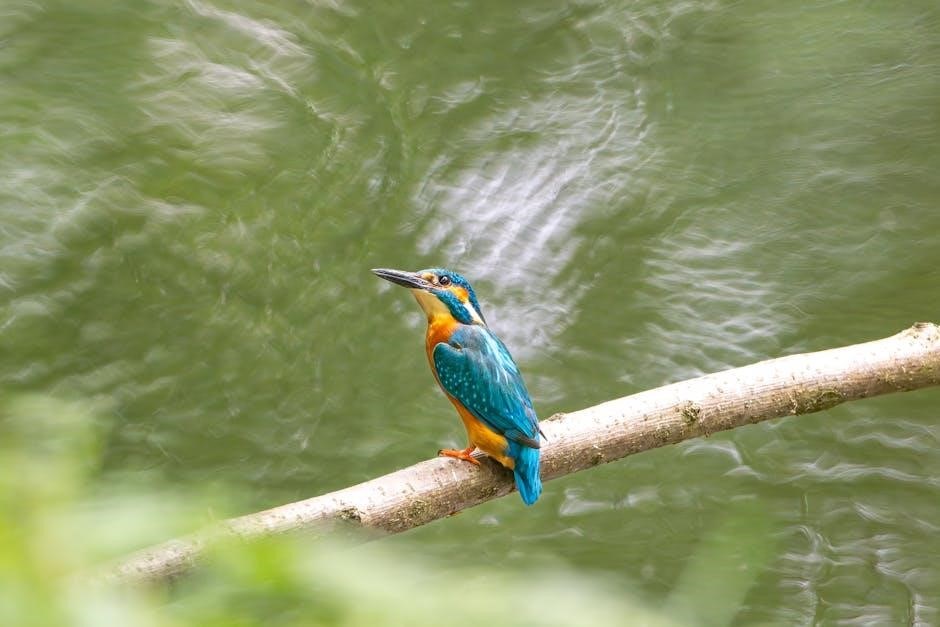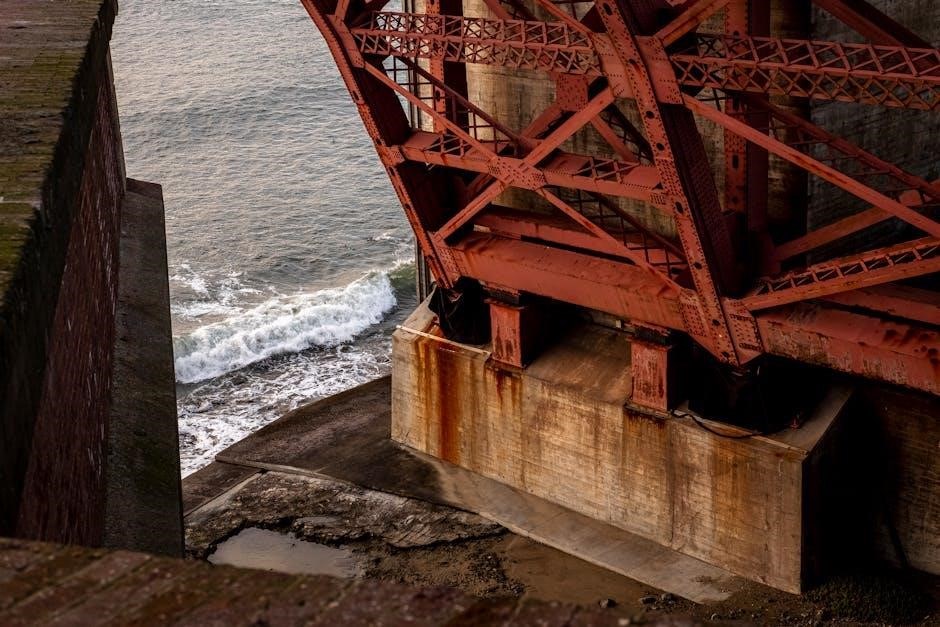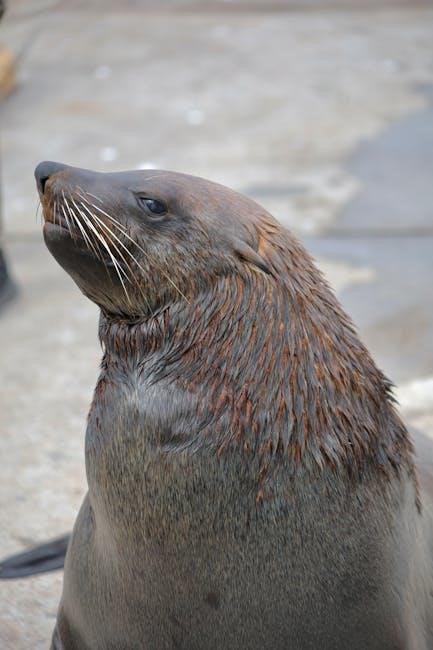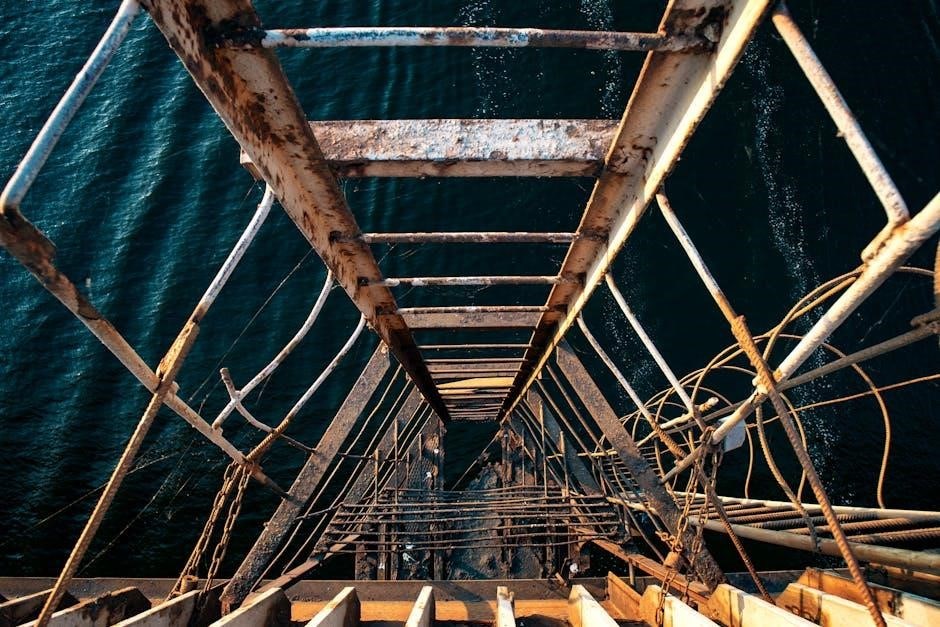
Underwater welding, or hyperbaric welding, is a specialized process used to join metals beneath the water’s surface, essential for marine and offshore infrastructure maintenance and construction.
Definition and Importance
Underwater welding, or hyperbaric welding, involves joining metal components beneath the water’s surface. It is crucial for marine infrastructure, offshore construction, and repairing submerged structures like ships and pipelines. This specialized technique is essential for maintaining and extending the lifespan of underwater assets, ensuring safety and functionality in harsh environments. Despite its challenges, underwater welding plays a vital role in global industries, requiring skilled professionals to perform precise and durable welds under extreme conditions.
Applications and Uses
Underwater welding is primarily used for repairing and maintaining ships, offshore oil rigs, and pipelines. It is also employed in the construction of underwater structures like bridges, dams, and gas pipelines. Additionally, it plays a key role in salvage operations and the repair of submerged vessels. The technique is essential for ensuring the integrity and longevity of marine infrastructure, preventing corrosion, and maintaining the structural safety of underwater assets, making it a cornerstone of modern marine and offshore industries.
Safety Considerations
Underwater welding poses risks like electrical shock, gas bubbles, and pressure hazards. Proper equipment, trained divers, and strict protocols are essential to ensure safety and minimize risks.
Protocols and Risks
Underwater welding requires strict adherence to safety protocols due to inherent risks like electrical shock, explosive gas bubbles, and pressure-related hazards. Divers must use specialized equipment, including waterproof electrodes and pressurized chambers, to mitigate these dangers. Proper training and real-time monitoring are crucial to prevent accidents; Additionally, environmental factors such as water currents and visibility can further complicate the process, necessitating careful planning and execution to ensure both the welder’s safety and the integrity of the weld. Regular equipment inspections and emergency response plans are also essential components of underwater welding operations.
Emergency Procedures
In underwater welding emergencies, immediate action is critical to ensure safety. Divers must halt operations and evacuate the area if gas bubbles or electrical malfunctions occur. Emergency response plans should include rapid ascent protocols and decompression procedures to prevent health risks. Support teams must be ready to assist with equipment failures or entanglements. Post-emergency checks are essential to assess weld integrity and equipment functionality before resuming work. Proper training and preparedness are vital to managing these high-stakes situations effectively and safely.
Equipment and Tools
Underwater welding requires specialized electrodes, hyperbaric chambers, and advanced tools to ensure safe and precise operations in aquatic environments and maintain structural integrity.
Specialized Electrodes and Consumables
Underwater welding requires unique electrodes designed to operate in wet conditions, often with flux-cored or metal-cased shielding to prevent porosity and ensure strong, durable welds. These electrodes are specifically formulated to withstand water pressure and corrosion, maintaining arc stability and weld quality. Consumables, such as waterproof fluxes and shielding gases, are crucial for preventing atmospheric interference. Their design ensures minimal spatter and maximizes penetration depth, making them essential for both wet and dry welding applications in marine environments. Proper selection of these materials is critical for achieving reliable underwater welds.
Hyperbaric Chambers and Dry Welding Setup
Hyperbaric chambers create a dry environment for underwater welding, enabling welders to work in a pressurized, water-free space. These chambers are sealed and pressurized to prevent water ingress, allowing the use of standard welding techniques. The setup includes specialized gas systems to maintain a safe atmosphere, ensuring precise control over pressure and humidity. This method is ideal for complex repairs and high-integrity welds, offering better control and quality compared to wet welding. The chamber’s design and operation are critical for successful dry welding operations in deepwater environments, ensuring safety and efficiency.
Wet and Dry Welding Techniques
Underwater welding involves wet and dry techniques. Wet welding occurs underwater, while dry welding uses hyperbaric chambers to create a dry environment for precise operations.
Wet Welding Methods (SMAW, FCAW)
Wet welding primarily employs Shielded Metal Arc Welding (SMAW) and Flux-Cored Arc Welding (FCAW). SMAW uses a waterproof electrode, ideal for underwater conditions, while FCAW offers better performance in dirty or wet environments. Both methods are portable and adaptable, making them suitable for complex underwater repairs. SMAW is simpler and more common, whereas FCAW provides higher welding speeds and stronger welds. These techniques are essential for maintaining marine infrastructure and pipelines, ensuring durability and structural integrity underwater.
Dry Welding Techniques (Hyperbaric Welding)
Dry welding, or hyperbaric welding, involves creating a dry environment underwater using a pressurized chamber or habitat. This method eliminates water contact, reducing risks and improving weld quality. It is often used for critical repairs and new constructions where high precision is required. Hyperbaric chambers allow welders to work in a controlled atmosphere, ensuring consistent results. This technique is more complex and costly but offers superior weld integrity compared to wet welding, making it ideal for large-scale projects and sensitive applications.

Step-by-Step Welding Process
Underwater welding involves preparing the site, setting up equipment, executing precise welds, and conducting post-weld inspections to ensure quality and safety.
Preparation and Setup
Preparation for underwater welding involves selecting the appropriate method, such as wet or dry welding, based on the task. The site must be cleaned and prepared, removing debris or corrosion to ensure proper weld adhesion. Specialized equipment, including waterproof electrodes and hyperbaric chambers, is assembled and tested. Divers or operators conduct safety checks and establish communication systems. Environmental assessments are performed to minimize ecological disruption. Proper setup ensures efficient and safe execution of the welding process.
Execution and Post-Welding Inspection
Execution involves carefully applying the welding technique, maintaining consistent arc control to ensure strong, defect-free joints. Post-welding inspection is critical, utilizing methods like visual checks or non-destructive testing (NDT) to assess quality. Any imperfections are documented and addressed. The surrounding area is cleared of debris to prevent contamination. Proper documentation and reporting are essential for future maintenance and compliance. Safety protocols remain in place during inspection to protect personnel and ensure the integrity of the weld.
Challenges in Underwater Welding
Underwater welding faces extreme conditions, including water pressure, corrosion risks, and limited visibility, making it technically demanding and requiring specialized skills and equipment to ensure safety and quality.
Environmental and Technical Difficulties
Underwater welding faces significant environmental challenges, including water pressure, corrosion risks, and limited visibility. Technically, maintaining stable arc conditions and preventing hydrogen absorption in welds are critical issues. Additionally, marine life interference and varying water temperatures complicate operations. These factors require specialized equipment and skilled operators to ensure weld quality and structural integrity, making underwater welding one of the most demanding engineering tasks in aquatic environments.

Applications of Underwater Welding
Underwater welding is crucial for maintaining and repairing marine infrastructure, including ships, offshore oil rigs, and pipelines, ensuring structural integrity and operational safety in aquatic environments.
Ship Repair and Offshore Structures
Underwater welding is vital for repairing and maintaining ships, offshore oil rigs, and marine infrastructure. It ensures structural integrity, preventing catastrophic failures and environmental damage. Wet welding techniques, such as SMAW and FCAW, are commonly used for ship hull repairs and pipeline maintenance. Specialized electrodes and tools enable welders to work effectively in harsh aquatic conditions. This process is critical for extending the lifespan of marine vessels and ensuring the safety of offshore operations, making it indispensable in modern marine construction and repair industries.
Training and Certification
Underwater welding requires specialized training and certification. Programs often include intensive courses in wet and dry welding techniques, safety protocols, and hands-on experience to ensure proficiency.
Education and Professional Courses
Professional underwater welding courses emphasize hands-on training and theoretical knowledge. Students learn wet and dry welding techniques, safety protocols, and equipment operation. Programs often include metallurgy, pressure effects, and environmental considerations. Practical experience is gained through simulated underwater scenarios. Certification requires passing rigorous tests and demonstrating proficiency in various welding methods. Many institutions offer specialized diplomas or certificates, preparing individuals for careers in marine construction, offshore repair, and industrial diving. These programs ensure welders meet industry standards and safety requirements.

Recent Advances and Innovations
Advancements include haptic devices for training and laser vision sensing for real-time weld monitoring, enhancing precision and safety in underwater welding processes.
Technological Developments in the Field
Recent advancements in underwater welding include the use of haptic devices for training and laser vision sensing for real-time weld monitoring. These innovations improve precision and safety. Additionally, automated systems for pipeline welding and advanced plasma welding techniques have been developed. European engineers have also demonstrated revolutionary underwater welding technology, enhancing efficiency and reducing risks. Such developments highlight the continuous evolution of underwater welding, making it safer and more efficient for marine and offshore applications.

Environmental Impact and Responsibility
Underwater welding must minimize ecological damage by reducing waste and avoiding harm to marine life, ensuring sustainable practices and adherence to environmental regulations.
Minimizing Ecological Effects
To minimize ecological effects, underwater welding employs specialized techniques that reduce waste and prevent contamination. Using waterproof electrodes and controlled welding processes helps protect marine life. Additionally, adherence to strict environmental regulations ensures that operations are conducted with minimal disruption to ecosystems. Regular monitoring and cleanup of welding debris further mitigate potential harm. By adopting sustainable practices, underwater welding can reduce its ecological footprint while maintaining the integrity of marine infrastructure.
Underwater welding is a vital technique advancing marine infrastructure and repairs, ensuring safety and durability. Its future lies in innovation and sustainable practices, driving industry growth.
Future Outlook and Importance
Underwater welding is poised for growth with advancements in automation and environmental-friendly technologies. As industries expand offshore, its role in marine infrastructure and energy production will escalate, ensuring safer and more efficient repairs. Innovations in hyperbaric welding and eco-conscious practices will drive its evolution, making it indispensable for sustaining global maritime economies and addressing climate challenges effectively.